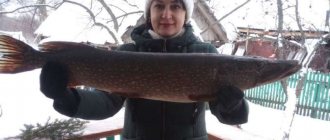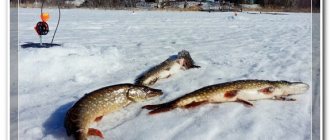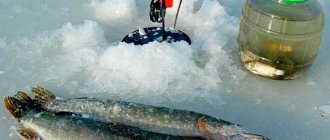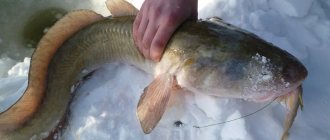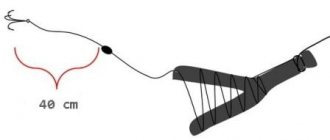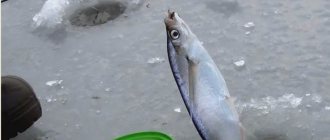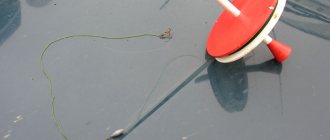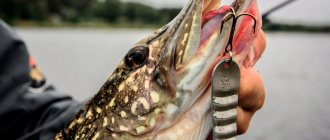The main season for catching pike on girders is traditionally considered to be the period of the very first ice.
Some time after the ice has become fairly strong, the pike feeding subsides. However, its bite does not stop at all and pike can be caught more or less consistently until the very last ice, including in the dead of winter. Especially on the Volga reservoirs.
On small reservoirs, and without a current, the situation is more sad: within a couple of weeks after the ice hardens, pike bites become so rare that many anglers who still visit the reservoir do not set up girders, because they have put them out in vain several times.
When I visit a small pike reservoir, I always put out girders. The main purpose of fishing here is usually to catch perch, roach or bream, and I place the heels of the girders as I go and practically don’t touch them until the evening. Sometimes, of course, I’m too lazy to bet, but I remember that you can catch a pike on a girder in any winter month, and sometimes such bonuses happen...
Content
- Catching pike on girders in winter
- Types of vents With a wide base
- With legs
- With slats
Zherlitsa fishing is one of the most exciting and exciting types of winter fishing. However, all the delights of this species can only be experienced when your goal is to catch a spotted predator, that is, pike.
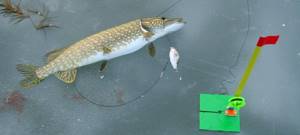
Habitats
Before catching a pike, you need to learn as much as possible about its lifestyle. Let's start with the fact that pike is a fish that does not like to gather in schools. The favorite habitat of adults is deep snags. Winter pike fishing takes place in places with changes in depth. For example, on the slopes of holes, pools, even if the bottom is smooth, there is a difference in depth. If there is a strong current, then look for pike in calm water. The older and larger the pike, the more authority it has among its relatives.
The habitat of several adult pikes does not coincide. As befits a true predator, she hunts alone. She strives to live alone from a very young age, and if there are a lot of pike in the reservoir, then she can look for her place for a long time. Smaller and younger fish, the squint, live in shallow water. They hide in thickets of grass. The young animals choose a place where the oxygen regime is favorable and there is still vegetation left after the first ice. In small waters, the weight of such pups can reach from 1 to 1.5 kilograms, but they are a minority. Therefore, there are often a lot of pike in shallow water, but these are often individuals weighing 500 grams.
Fishing for pike in winter and how to catch this predator, watch the video.
Pike, which are found at depth, have a dense, short body, slightly flattened. Deep pike can reach 10 kilograms in weight. The fish that feed in the vegetation on the reaches are herbaceous and have a long body, although they can also reach impressive sizes.
Catching pike on girders in winter
Pike is an enviable trophy for most fishermen, catching which brings great pleasure from the fishing process itself, especially in winter.
Today we will look at this type of fishing in more detail, find out what a standard girder consists of, understand the basic tactics of fishing for it and learn how to find “pike trails” in a reservoir.
First of all, let's look at the most popular types of this gear, which can be roughly divided by type of design.
Where to look for pike in winter
Finding pike in winter is not as straightforward as, for example, when fishing for pike perch. The general tendency to strive for greater depth in the wilderness continues, but this is far from the rule. Here, the angler will be helped by a thorough knowledge of the reservoir and remembering the points from which pike, especially large ones, were once caught. The toothy huntress chooses certain points for her location or walks along her favorite paths. And if such a place becomes vacant (for example, due to fishing), then a new hunter will soon take it. This is especially true for large individuals. Seasoned predators occupy the best places, simply expelling or eating smaller brothers. Such points are remembered and caught again on other fishing trips.
Depth
It is impossible to definitely determine where and at what depth the pike stands in winter. This manifests itself differently in different bodies of water. In January and February, it is better to search deeper water areas, edges and holes with snags, the lower and upper parts of coastal dumps and underwater flooded channels. But even in shallow coastal waters you can find a trophy specimen, especially if there are few deep places in the reservoir or there has been a long-term thaw. Usually, more or less deep holes with snags, and other suitable places for ambush, are occupied by large individuals - they will simply eat or drive out the pencils. But if such places are not enough with a large population of predators, then in the coastal zone, along with pencils and grass, hard-toothed monsters are also found. They are also present in the vast shallow waters of reservoirs, overgrown with reeds and reeds in summer.
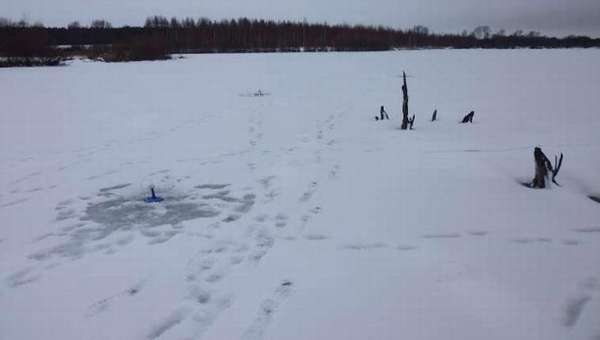
Trophy copies
Where do large pike live in winter? In the best places for an ambush, subject to normal oxygen conditions and an abundance of forage fish. According to their pike hierarchy. If the bottom topography is unknown, then you need to check all promising places, lonely logs under a dump, flooded snags and thickets of vegetation. If you can look for small and medium-sized robber fish where there are a lot of perch and roach, then for seasoned specimens this is not a factor. Large specimens hunt anything that can fit into their huge mouth, including smaller brothers. To catch a larger trophy in winter, you need to scout out such “nooks”, remember them and check them periodically.
Operating points
Promising places for searching and fishing:
- Coastal thickets of underwater vegetation and reeds, up to half a meter deep.
- In ponds and small reservoirs - on deep flooded channels, edges, any bottom anomalies with shelters.
- In case of poor oxygen conditions - closer to the upper reaches, places of confluence of rivers and streams, near underwater springs and springs.
- Shallow places with strong snags.
- Lonely old snags.
- In rivers and streams there are bends in the channel, bays, calms after the stream behind the cape, spits and ends of islands protruding into the reservoir, deep places near the shore with overhanging trees and bushes.
- Edges, slopes, navels among the depths, entrances and exits from pits.
- In lakes and quarries there are changes in depth, underwater steps, thickets of algae and water lilies, and large boulders.
- In small, shallow, blind ponds (without the confluence of rivers and streams) due to low oxygen levels, the spotted predator may not bite at all, except during periods of the first and last ice, as well as thaws.

Types of girders
Wide base
The most popular type of this gear. The design of this girder is very simple.
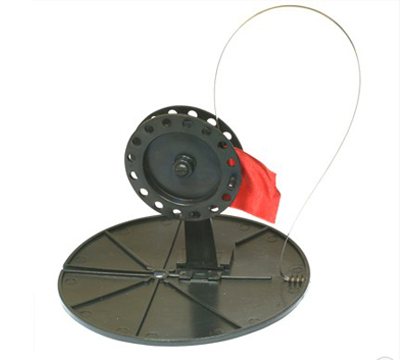
Base. Most often, its base is made of plastic, less often wood. The shape is a circle, 20-25 centimeters in diameter, with a slot for passing fishing line under the ice. In addition, there are also special holes for installing a flag and a stand.
Rack. Mounted in a special hole in the base. The reel is installed on the stand.
Coil. Made from plastic. It is installed on the stand in a special way to ensure free movement when rotating in any direction when biting. Sometimes there are special marks on the spool to better see its rotation.
Checkbox. Mounted in the bottom of the vent. When bitten, it straightens and signals that the fish is interested in the bait.
With legs
This type of vents is used where there are high snowdrifts and snow deposits on ice. It is very easy to catch with them, because it is very clearly visible from a great distance. Structurally, this type of gear has one or three legs for greater stability.

Like vents with a wide base, this type consists of almost the same elements:
- three or one leg;
- rack;
- coil;
- checkbox.
However, there are some distinctive features. In this case, the stand is the main element of the entire tackle, and everything else is mounted on it. The flag is attached to the top, the legs or foot are attached to the bottom, and the reel with fishing line is in the middle.
By the way, if you choose a vent with one leg, then it is advisable to freeze it in ice. In addition to the fact that this will ensure high stability of the tackle, even with this design the leg will serve as a stand. The reel and flag can be attached directly to it.
With slats
Fishing with this gear is very convenient thanks to the installation and transportation of such girders. They practically do not require assembly operations on the ice of a reservoir, since they are most often assembled at home in the following sequence.
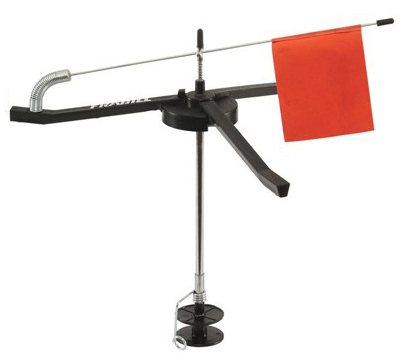
- A spool of fishing line is mounted at one end of the rail;
- On the other side is a flag;
- A small hole is drilled in the middle of the rail, into which the fishing line will later be threaded into the hole;
- At the end of the fishing line, which was passed through the hole in the rail, the equipment is mounted. Installation is ready.
Catching other fish with winter baits
Pike is not the only fish that is caught with girders. In the wilderness, burbot becomes a worthy trophy. He bites on live bait, on fallen bait (but fresh!), on worms, and on other baits that may require less fuss. True, mostly at night and in the most severe frost, which is not always convenient for the fisherman. For night fishing, fireflies are attached to the flags. They use the lightest ones so that they do not upset the balance of the flags and do not outweigh them; they simply sew them to the flags with threads. If there is a full moon, the flags will be visible at night and without fireflies.
When fishing with small live bait, perch is often caught along with pike. These can be any species - from small perches weighing 50 grams to handsome one-kilogram beauties. Most often this happens during the first ice, when perch and pike stand in almost the same places, then the pike moves deeper. For perch you need to use live bait weighing no more than 30-40 grams. Such live bait is rarely available for sale; it is usually caught right there at the site where the girders are installed.
Pike perch is a rare trophy when fishing with live bait in winter. It is not very active at this time of year, much less perch and pike. However, where they found a pike perch trail, it makes sense to put a couple of girders. They can show whether a fish has approached or not, even just by triggering a flag without taking it. This means that you can take a spoon, a balance beam and move to the place where this predator is caught.
Rotan is another fish that can be caught very well on a winter bait. They do not use live bait as bait, but a worm; they do not use any leashes. It practically does not survive where there is a pike, and there is no need to be afraid that it will bite off the fishing line. Rotan bites actively, especially at the beginning of winter on the first ice. They usually manage to place no more than five zherlits - while they are placing them, the first ones are already starting to peck, and they don’t have time to do any more. This kind of fishing is much more effective than catching rotan with a spinner, jig and other baits with one or two rods and allows you to quickly localize its accumulations in the pond. You need to put a 0.25 line and a weak tuck on the girders, you have to run quickly to the bite, since the rotan will then swallow the hook deeply, and you will have to pull it out with the throat.
You can ask your question to our author:
How to install a vent yourself
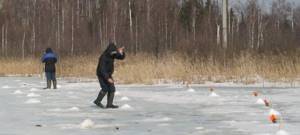
The tackle has been selected, now it’s time to begin its installation and rigging. To do this you will need to wind on a reel. 10-12 meters is enough. The thickness for pike is not less than 0.3 and not more than 0.5 mm.
As for leashes, as in the case of summer fishing, they are simply necessary. Length - from 10 to 15 cm.
The presence of a weight is determined by the current and its strength. In any case, the purpose of the load is to hold the bait, not allowing it to float to the surface of the ice, pull the line off the reel, or even swim away into the thicket, where it will reel in the line.
As for the hooks, the zherlits don’t have a definite answer. Fishermen use both singles, doubles and triples.
Adjusting the flag is an important point. The main thing is to adjust it so that it does not work when the live bait moves. The fact is that in winter the pike is very careful, and when it feels a flag, it will simply spit out the bait.
Live bait for pike
As practice shows, it makes sense to choose the size of live bait based on the size of the fish. Typically, pike take well on fish that are about ten times less than their own weight. For example, to catch a one-kilogram predator you will need a hundred-gram live bait, and for half a kilo you will need fish weighing 50 grams. This is a fairly large live bait. Live bait from 30 to 100 grams should be considered universal. Even a small pike can bite on live bait with only half its own weight, and a large five-kilogram pike can be tempted by small fish. There is no need to be too attached to the size of the bait, just don’t be afraid to hook fairly large fish. Usually they are caught using several baits, for which you can use different caliber live baits, which will increase the chances.

It makes the most sense to use those live baits that live in the fishing area. They are common food that does not cause suspicion. You can usually catch them right at the fishing spot using a jig and a float rod. However, it happens that live bait refuses to bite. Therefore, it is better to take some purchased live bait or one caught in another body of water when fishing, so as not to be left without a tail. And then, when you manage to find the key to the fish, catch local live bait.
When purchasing, you should pay attention to the breed of fish. The simplest and most affordable live bait for pike is roach. Sold from 5 to 30 rubles per piece, depending on the region. It is better to buy live bait from a hook, since live bait from a net has frayed fins and damaged scales; they are less viable. Also, the purchase should be made immediately before fishing in order to worry less about safety.
Roach has the shortest “shelf life”. Crucian carp, perch, and ruff will last a little longer at home. You can use lamprey, rotan. The latter should be taken with caution, as there is a risk of introducing a weed species. Of course, it is not a competitor for pike and perch and will be quickly destroyed. But if it turns out that there are none in the reservoir, it can multiply and create problems. In order for live bait to live longer, it should be kept in cold water. Ice from the refrigerator, or preferably from the street, is added to the water. It is advisable to put one large piece there and cover it with a lid, so it will take longer to melt. Those who have an aquarium compressor use it. In large stores, to preserve live bait, they use special oxygen bags that are placed in the water.
In order to move live bait around the reservoir, it is convenient to take a cane and a trough-sled. A can, a box, a bag with lanyards, and an ice auger are placed on the trough and travel to the fishing spot after the angler. In your hands, all this rubbish will interfere with walking, and the voluminous can of water is also heavy. Therefore, a trough is a mandatory attribute for those who plan to seriously fish with girders.
Catching live bait on the spot
For fishing, use a jig and a float rod, with the thinnest fishing line and a small hook. Chernobyl, bloodworms, worms, and dough are used as bait. Sometimes small perch are caught using small spoons. A universal live bait tackle must be recognized as a small balalaika fishing rod with a very thin fishing line and the smallest tungsten jig. You can bait dough on it too, the roach doesn’t really understand that it’s a non-living bait and takes it as if it were a living one.
It is better to select jigs so that, with the same light weight, they have different hook sizes. This is necessary so that the bait does not swallow the hook and gets caught right behind the lip. To extract, you must have a small extractor. It is convenient to have two or three pre-equipped live bait fishing rods with different hooks on jigs for different sizes of live bait.
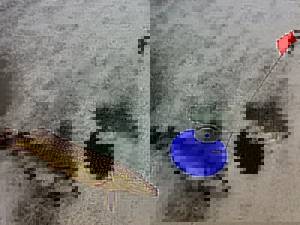
The main thing is to position yourself so that the placed girders are in sight, and the kana is at hand. The caught fish is placed in it. Usually, in the cold, fish do not sleep like they do in summer, and there is no need to take additional measures to preserve them in the can. Therefore, it is very important to position the place for live bait fishing and setting up the bait. The place where pike is caught is taken into account, the place where the live bait bites and the direction of the wind, to which it is advisable to sit with your back or at least sideways, covering the hole and the nod of the fishing rod with your boot from the wind. If this is not possible, you should keep your ears ready and react to the click of the flag in order to run and hook.
During live bait fishing, they are often caught using several rods. To do this, drill two or three holes side by side in the selected location. They put jigs and float winter fishing rods in them, which should all have stands. They use alternating play on different gears. It happens that a fish is attracted by a jig, and then only bites on a float rod with a fixed attachment, and this does not work in any way.
If you find a good place for live bait, it makes sense to feed it a little in order to delay the flock. They use neutral bait compositions and homemade porridges. The fish will stay in place longer if there is some food for it. But you can’t hope to attract fish to a place where there are none now by feeding them. Smells, even the most delicious ones, spread weakly in cold water, and in winter it is easier to attract a flock of live bait by playing with a jig than with the most expensive and tasty bait. In any case, if there are no bites for a long time, you need to change the fish and look for it, and not hope that it will come on its own. Usually, where the live bait is found, there is also a pike, and it is worth placing the girders there too.
How to bait live bait
The answer to this question will depend on what bait you are using. For example, non-spiny fish, such as roach, are best baited by the mouth. But for perches or ruffs, it is better to pierce behind the dorsal fin.
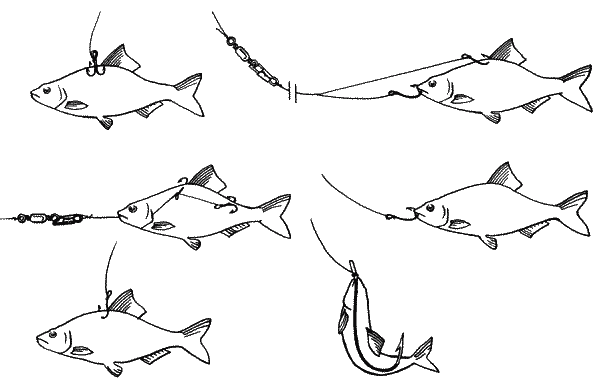
These tips do not have to be considered a rule, since every fisherman has his own subtleties and tricks in the matter of baiting bait. Let's look at the advice of one of them.
Fishing specifics
Before equipping the girders, it is worth assessing the fishing conditions in advance. In November, pike often stay in the same locations as in summer. In December, with the approach of the wilderness, it gradually slides into depth. There she can stay throughout January and February, making only short forays into the shallows.
Seasonality
It is better to start fishing on the first ice. Try not to miss this time. The most active pike bite in winter on girders lasts approximately 2-3 weeks after freeze-up.
In March, the predator rushes to the shores, often visiting the confluence of rivers and thawed streams and often stays in the upper layers of water. In the spring, you need to arrange the gear so that the live bait is at different distances from the bottom. After the pike marks the horizon of its location, it is worth reinstalling the remaining girders, adjusted for this.
Recommended reading: Baikal grayling
The largest single pike still occupies deep areas of the reservoir near underwater springs, briefly going out to hunt in snags and near-channel edges. Purposeful hunting for such a trophy brings fewer bites, but the size of the trophy more than compensates for this drawback!
Time of day and weather
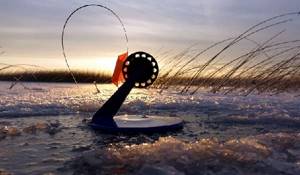
You can count on a good bite throughout the day, but pike are most active in the early morning. In cloudy weather, the bite time is usually more blurry and you can count on a good catch even at the height of the day. Especially with a light, steady wind blowing from one direction.
Having explored the waters a little, you can stock up on gear and go catch predatory fish. Live bait can be caught in the same body of water, but many people prefer to purchase them in a store before fishing. The second option, of course, saves a lot of time. After all, most often, a good bite begins at dawn.
A few important nuances
To catch a pike, it is important to consider several points:
- A properly placed live bait can play a key role and significantly help the angler if it is known exactly where the pike concentration is located. There will be bites in almost any weather conditions.
- The fish, having noticed the bait, at first can simply watch it, not daring to bite. At the same time, anglers often have the opinion that there are no pike here at all. This is mistake! The predator reacts very sensitively to the movements of live bait. She is able to sense the unnatural movements of a wounded fish from a long distance. Even a well-fed pike is instinctively interested in live bait; “persuading” a passive predator to attack is the goal of a professional.
- The following simple technique helps provoke a pike attack. You need to pull the rig up and down several times. A suddenly moving, sedentary live bait dramatically increases the chances of a pike catching it.
- In case of severe frosts and sunny weather, it is better to refuse fishing. On such days, the fish usually lies on the bottom, being there in a half-asleep state. Experienced fishermen focus on pressure surges, as they greatly influence the behavior of the pike. Fishing should be scheduled on a day when the weather is more or less stable and the daily difference in atmospheric pressure does not exceed 10 mm. mercury column.
Choosing a fishing spot
It’s easier to fish in winter on an already familiar body of water, where pike sites have long been known. However, if this is not possible, you will have to look for new places. The tips below will help you catch more big fish:
- It is best to choose a place for installing vents near snags, as well as near thickets of reeds or reeds.
- In swampy shallow waters, as in summer, grass pike are more often found. These are mainly individuals up to 1 kilogram in weight. Even such a small fish will not stay there for long. The point is the lack of oxygen in these places. The muddy bottom releases a lot of methane, which concentrates under the ice; the fish are simply forced to leave such areas, going to depth.
- A very promising place is the transition between pits with a relatively hard bottom. Pike live here almost the entire season. By placing gear in such a location, the chances of catching a trophy increase significantly.
- When fishing on the river, it is better to install the girders on a steep bank. The current near this shore is slow and there is usually a deepening.
Considering that the pike has an oblong body shape, there is no need to drill large holes. The universal diameter of the ice drill is 130 mm. It’s not worth drilling “hundredths and hundredths”, since due to frost during the day the hole narrows and there is a chance of biting a trophy pike, which cannot be pulled out even with the help of a hook.
Rules for installing vents
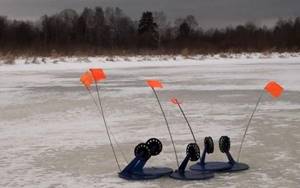
Once the location has been selected, you can begin arranging the gear. It is better to do this in the dark. The process of installing vents involves drilling many holes. It is important to do this before the bite starts. Otherwise, you risk spooking the fish and it may move.
Recommended reading: Catching pike perch by trolling
One part of the vents is usually installed in shallow water, the other - at a considerable depth of the reservoir. This allows you to determine exactly where the fish are located. It is preferable to install gear along the shore and on the edges to increase fishing efficiency. Pike is an ambush predator, so it is found much more often in places with bottom anomalies.
It does not matter in what order the vents are installed. It is recommended to keep the distance between them no more than eight meters. It is advisable to trample the paths to the holes a little if there is a lot of snow on the ice.
Tactics and fishing techniques
When going fishing, you need to take into account that catching pike in winter on girders requires a quick reaction and some preparation.
Small tricks of girder fishing:
- a well-chosen location and well-tuned gear will guarantee success;
- knowledge about the habits and character of pike will be an ace in the hole;
- the use of leashes will significantly reduce the number of line breaks;
- any movements, especially steps, must be quiet, the pike reacts to noise and the bite may worsen;
- For a more successful search for a place, it is useful to use any echo sounder. Knowing the terrain helps to place gear in more “correct” places. Advanced models of echo sounders will also show the fish itself, its quantity and size;
- The number of girders increases the number of bites, but you need to find a balance in order to have time to run up to the triggered flags.
- If there are no bites in certain holes for a long time, you should check the live bait, and if they are mobile, move the girders to another place.
Hooking and landing
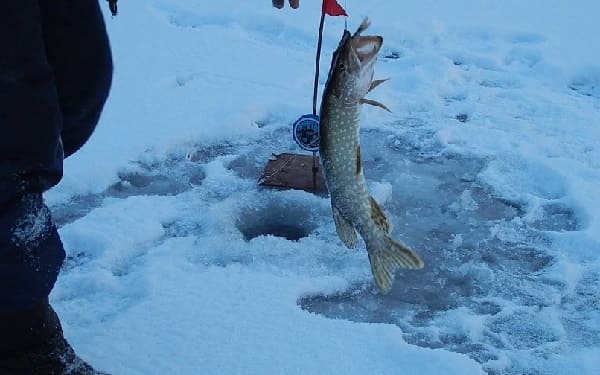
There is an important point in the process of pike fishing. After the bite, the hook is not done immediately. You need to give the predator time to swallow the bait.
Having grabbed the fish, the “toothy” one holds it tightly in its mouth for some time. Only a little later, usually stopping, it begins to turn over and swallow the prey.
As soon as the hook has been made, it is necessary to keep the line tight. Fishing is best done with your fingers. Small squinting cubs can be pulled out immediately, but with a trophy predator, you may have to tinker. If a large fish bites, you need to pull it, periodically loosening the line. Such manipulation will allow you to hook the pike by the so-called “mustache”. Then it will be possible to pull it out more calmly, since the risk of “snipping” the fishing line disappears. In general, fishing for girders is simple, exciting and productive. Sometimes, instead of pike, you come across trophy perch, pike perch or other predatory fish.
How to find “pike trails” - video
Selecting, buying, preparing and equipping a zherlitsa does not mean that you are ready to become a real zherlitsa. To increase the likelihood of catching a predator with this tackle, you need to know where and how to look for “pike trails.”
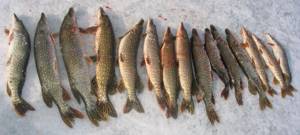
Tip #1. As soon as the ice has established itself and you can walk on it, it’s time to look for the toothed one in the shallower coastal areas of the reservoir. For example, it can sit in thickets, under snags and, of course, in the area of the drop from depth to shallow.
Tip #2. As soon as strong ice is established, pike food (small fish) loses activity and slides into holes, which means that you need to look for pike there. Therefore, in the middle of winter, experts advise looking for pikes in slopes near wintering pits.
Tip #3. If in the dead of winter nature spoils us with prolonged thaws, then the pike, following the food supply, moves to shallow places.
Tip #4. In winter, you are more likely to find pike in the area where streams and rivulets flow, where there are a lot of small fish in the fresh stream.
Tip #5. Snag, this particular place is considered one of the most interesting places for snag. If there are snags at the bottom, then sooner or later you can find pike there, provided that the oxygen regime there is not disturbed. On a large body of water, the snag, as a rule, also works in the dead of winter. However, when fishing in snags, be careful and always take a cutter with you when fishing.
For those who don’t want to read, we present a video on how to find “pike trails” and install girders on them.
How to correctly arrange the vents?
So, gear should be placed in different parts of the reservoir, this will increase the chances of success.
Before proceeding with the installation of girders, it is recommended to drill the required number of holes in the most promising places in the reservoir; the distance between holes should exceed 8-10 meters.
During the fishing process, it may be necessary to rearrange the girders (change location), so it is recommended to immediately drill 10-15 holes more than the number of girders.
It is necessary to start installing gear from shallow water, gradually moving to depth. Note that on the first ice, pike are more often found in areas with a depth of 2-3 meters rather than 5-7 meters. It is enough to have 15-20 girders at your disposal. After installation, a bite can follow almost immediately, but this is only if you manage to find a place where the pike is hunting at that moment.
If after installing the tackle there are no bites for two hours, then it is recommended to move the tackle to another place, for example, if it is on the shallows, then we move it closer to the depth and vice versa. When fishing at a depth of more than 5-6 meters, the time to wait for a bite should be doubled.
How to determine a promising place for fishing?
The ability to choose the right place for fishing is half the success. Therefore, we will consider the main points that are important to consider when choosing a promising place for pike fishing in the winter.
- So, having arrived at the reservoir, you immediately need to look around, paying attention to the coastal zone. It would be correct to install several girders a few meters from the reeds; pike will always be there during the first ice, provided the weather conditions are favorable. Exits from bays should not be passed by if a fallen tree is found in the water; it is also necessary to install 1-3 vents.
- The best place for fishing is an area with sharp changes in depth, as well as exits from holes. If you want to catch a large pike, then it is important to know that it lives and hunts only at depth, so we are looking for the deepest place, namely a hole. The gear here must be installed not above the deepest point, but at the boundary of the depth difference towards the edge.
- When everyone from the nastia is placed, we look at where the bites are happening, in this direction and begin to shift, but at the same time do not forget about the distance between the girders.
Design features of the vent
The vent can be made in different ways, but regardless of this, the principle of its operation will be the same in all cases. Let us note the main structural elements of this gear: signaling device, stand, reel. When choosing a reel, you should opt for models that do not have axial play.
- After installing the tackle, the distance between the reel or ice should exceed 10 cm. The selected reel should have sufficient space to store 15-20 meters of fishing line with a cross-section of 0.3 mm.
- The coil should be at a distance of 2-3 mm from the holder.
In addition, the reel must have a ratchet, in other words, a brake, the presence of which will not allow the pike to easily remove the supply of fishing line from the reel after biting.
Now regarding the alarm. So, this element of equipment should not be triggered by the force of a fish weighing up to 150 grams.
Why? Often, especially when catching large fish, live bait weighing 100 grams or more is used, and if the alarm is too sensitive, it will not be difficult for the live bait to knock down the installed alarm.
A small piece of red fabric is tied to the highest point of the alarm; its presence will allow you to notice a bite in a timely manner.
And lastly, when preparing a fishing line for pike, you must use doubles or tees, which are attached to the main fishing line through a tungsten or metal leash 15-20 cm long.
Live bait attachment and gear adjustment after installation
Live bait (small fish) is used as bait when fishing for pike with a girder. It is important to note that the live bait used must be obtained from the reservoir in which it is planned to catch the predator. Roach, gudgeon, and small perch are ideal as live bait. In the case of the latter, you will need to cut off the dorsal fin.
- An important requirement for bait is that it must be alive. The chances of catching a pike with dead bait are significantly reduced; only a hungry predator will react to such bait. You can hook the fry in several ways: by the back or upper lip.
- The first method can be used when the predator is highly active. This mounting option severely injures the fry and after this it will not live more than half an hour. If the fry is hooked by the upper lip, then on the hook it will behave much more actively, which increases the chances of success.
- The choice of baiting method depends on the conditions in which you will be fishing. So, when fishing in the depths or in snags, the first option is more suitable; when fishing in the shallows, you can safely use the second of the proposed methods.
- Once the bait is on the hook, you can install the tackle. There is nothing complicated here.
- We lower the bait until the weight, which is installed next to the leash on the carbine, falls to the bottom, after which we take the fishing line at the edge of the hole and raise it by about 10 cm.
We leave the tackle in this position, and install the girder itself above the hole, sprinkling its base with a small amount of snow. That's all, you can start installing the next rig, while not forgetting to look at the bite alarms of the already placed gear.
How does pike bite?
If the flag (signaling device) takes a vertical position after installation, this will indicate that our bait was attacked by a predator. In such a situation, you should act in different ways; in one case, you may need to start fishing immediately, and in the second, you may need to wait a little before hooking.
On days of high pike activity, which is observed during the period on the first and last ice, hooking must be done almost immediately after the start of the bite. In the middle of winter, as well as in the dead of winter (mid-January), pike activity is mostly weak, so after biting you need to wait a few minutes, thereby allowing the predator to swallow the prey.
You should not perform a sharp hook, you just need to pick up the fishing line and pull it slightly towards yourself, if you feel tension, you can start fishing, if not, then it is recommended to play with the bait, if a repeated attack does not occur, you can pull out the tackle.
When fishing for pike, you should not rush; you must constantly ensure that the line does not touch the edge of the hole, on the sharp edges of which it can rub. We slowly bring the pike to the hole; it is recommended to take it using a hook under the gills.
Source: https://naribalke.com/zimnyaya-rybalka/vse-o-lovle-schuki-zimoy-na-zherlitsu.html
How to recognize a pike bite
The tackle has been selected, live bait has been attached to it, the hole has been drilled and the girder has been installed, all that remains is to wait. As soon as you see that the flag has been triggered, it is advisable to immediately approach (but not run) to the gear in order to understand the reason for what is happening under the ice.
Pike bites on jig tackle look something like this:
- A toothy predator approaches the baitfish, inspects it, and grabs it across. With such a bite, on the surface of the ice the reel releases the flag and scrolls a little on its own;
- Next, the pike stops and begins to turn the prey forward with its head to swallow. At this moment the coil stops;
- The bait is swallowed, the predator begins to move, and the reel begins to unwind again. It is at this moment that most fishermen advise hooking, since if you do this before the bait is swallowed, you can miss the pike, since the bait can be torn out of its mouth.
We bring to your attention an interesting under-ice video about how a pike reacts to a baitfish underwater.
Next comes the process of fishing. Here experts advise that you should never loosen the fishing line. The main thing to remember is that if the pike moves easily, we pull it to the surface. If she gets up and resists, we release a little fishing line.
By the way, most beginners, when they see a pike right next to the hole, make a mistake. The main thing here is not to forget that, blinded by the light, she often makes a decisive jerk and tries with force to free herself. Don't miss out!
Useful tips
- You should approach a triggered vent carefully, without unnecessary fuss, so as not to scare away the toothy one. Pike perfectly hears everything that happens on the other side of the ice. Quite often, after a bite, the fisherman sees a bitten baitfish, which she spat out. A joyful exclamation at the sight of a raised flag, the steps of a running person, the shot of a bite alarm could scare her... in general, any unnecessary noise.
- It is important to set the depth correctly. If a live fish reaches the bottom, it will burrow into the mud or remains of vegetation, where the predator will not find it. With a standard reel size and a 25 cm long leader, 3-4 turns are usually made. Sometimes the toothy one takes good bait bait suspended at a height of up to one meter above the bottom surface.
- An echo sounder is the best assistant in choosing a fishing spot. Using this useful device, you can find promising irregularities on the bottom, among which it is convenient for pike to set up ambushes. In the dead of winter, she prefers to attack the fry from a shelter, rather than chasing after him and wasting precious energy.
- A fisherman must have a hook in his arsenal, and when fishing he is always at hand (for example, in his boot). In the middle of winter, live bait may be tempted by a truly trophy specimen, which will be very problematic to get into the hole without a hook.
Everything stated above can be disputed, because as many fishermen exist, there are as many opinions. Everyone independently determines for themselves how to catch pike in the wilderness, based on their own experience and observations.
Want to know more?
Then head to the special sections of our forum, where you can ask any questions related not only to the choice of a girder, but also to the tactics of fishing with this type of gear!
- Winter fishing;
- Tactics of fishing with a zherlitsa;
- Tactics for catching pike with a girder;
- How to choose live bait for a zherlitsa;
- How to choose a leash for a harness;
- Review, modification and tuning of the “Terminator” girder.
Friends, first of all, the article we presented is aimed at those who are thinking about pole gear for the first time, and are planning to purchase their first pole in the near future, and go to the pond - test their strength and acquired knowledge. We hope that after reading the article, beginners will catch their first pike and get unforgettable emotions from catching toothy predators with this tackle.
Live bait rig
Regardless of the design of the girder, you will need a device on which to attach live bait. It consists of one or two hooks, doubles or tees, a wire or tungsten leash, and a snap hook with a clasp. If a live bait is attached to a hook, they try to hook it in such a way that it is less injured - by the lip, near the edge of the anal fin, by the back near the edge of the dorsal fin. The longer the live bait is alive, the better. At the end of fishing, if it is in normal condition, the live bait from the hook can be completely released into the reservoir.
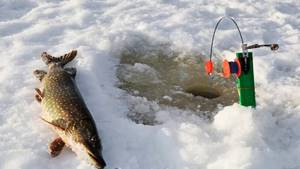
The simplest thing is to use a tee, which is attached to the end of the leash, and hook the fish by the lips. Sometimes they use a live bait tee with one small hook on which live bait is placed, and large ones for the predator, or the same double. The hook size is at least number 10 or larger. It is better to use two hooks. One is placed on a leash and slides freely along it, preferably on an additional wire bend, so that there is another degree of freedom. The second one stands at the end of the leash. The first hook is placed under the fish's anal fin, the second - behind the lips.
As practice shows, you should not use rigs that involve passing live bait through the mouth and gills. With this method, the fish lives much shorter than if it is simply attached to the lip, and is less mobile in the water. Consequently, there will be fewer bites on it. Now on sale there are various clips for live bait, with which you don’t have to pierce them with hooks at all. However, their feasibility must be verified. In addition, it is not known what is worse for the fish - a squeezing clamp that interferes with movement, or a small puncture in the lip and tail muscles. There are even more designs of live bait rigs than designs of girders, and the final choice of the fisherman must be tested by practice - which pike will spit out less often and take more often.
The main line for the girder should not be thinner than 0.25 mm. Even if a small pike bites, a 0.25-0.3 fishing line is convenient because it can be pulled out of the snow or ice if it is frozen. With a thinner, albeit good and strong fishing line, this will not work; it freezes very tightly and immediately. When winter fishing, braided cord is never used on girders.
Despite the deep winter, at this time it is caught with zherlitsa and pike perch.
It is clear that its fishing spots are closer to the fairway. But the time of his appearance for fattening most often falls in the twilight of the evening or morning. It is then that you can wait for a large pike perch to bite on live bait. But there is a secret here too. If you have the opportunity to catch bleaks, then you are guaranteed a pike-perch pie or aspic. The pike perch has a big tooth for this delicate fish... Where a fanged predator lives, and the girders are baited with roach and bleaks, most of the bites will come from the girders with bleak.
Zherlitsy for pike perch are placed along the edges of holes and sand spits, that is, on the edges and slopes in depth. Most often these are depths of six to eight meters.
Share with your friends!
